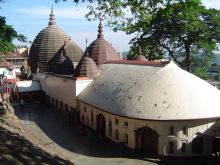 Places To Visit In Guwahati Links
Places To Visit In Guwahati LinksKAMAKHYA TEMPLE :
Over the centuries, Kamakhya Temple has been the seat of the powerful tantrik shrine of Shakti. It is regarded one of the 51 Shakri Peethas. Located around 800 ft. above the sea level on the Nilachal Hill , at a distance of 8 km from Guwahati City. The hill on which the temple stands commands a magnificent view of the surroundings including Guwahati city. 
The current temple structure was constructed in 1665 by Chilarai of Koch Dynasty in the style of medieval temple. The main temple has seven oval spires, each topped by three golden pitchers and images of Lord Ganesha and other Hindu Gods and Goddesses on the outside. Several smaller shirnes and temple dedicated to Kala Bhairava, Lord Shiva and other Hindu deities are also located in its vicinity.
The earlier structure was destroyed by Kala Pahar in early 16th century. Legends say that Kamdev, the God of Love, with the help of celestial architect Lord Vishwakarma built the original temple.
The Goddess Kamakhya is believed to be the granter of desire. According to the legend: despite her husband Lord Shiva’s disapproval, Sati had gone to attend the universal ‘yajna’ organised by her father Daksha. Shiva was not invited, and was also abused by Daksha. Unable to bear the insult, Sati committed suicide. Upon hearing the news , Shiv arrived on the scene, picked up the body and began a dance of destruction. Vishnu tried to pacify Shiva: the body was cut into 51 parts. The spots on earth where each part fell was identified as ‘peetha’. Kamakhya came into existence after the female genitia of Sati fell at the spot where the temple stands today.
Tradition has it that once in every year a three day festival attracts millions of pilgrims. This festival is called Ambuvuci, which is unique with its own significance. During this period Goddess Kamakhya is said to undergo her menstrual period and the pool containing the uterus in the temple turns red. Temple remains closed during this festival. Before closing the temple, white sheets are draped inside the temple. When the temple is opened after three days, the sheets are found red in colour. On the fourth day, great festivity is observed. The red sheets are torn into pieces and distributed amongst the devotees.
0 min read
 Back to Previous Section
Back to Previous Section